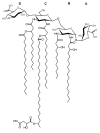Lipid A from Oligotropha carboxidovorans Lipopolysaccharide That Contains Two Galacturonic Acid Residues in the Backbone and Malic Acid A Tertiary Acyl Substituent
- PMID: 33121154
- PMCID: PMC7663294
- DOI: 10.3390/ijms21217991
Lipid A from Oligotropha carboxidovorans Lipopolysaccharide That Contains Two Galacturonic Acid Residues in the Backbone and Malic Acid A Tertiary Acyl Substituent
Abstract
The free-living Gram-negative bacterium Oligotropha carboxidovorans (formerly: Pseudomonas carboxydovorans), isolated from wastewater, is able to live in aerobic and, facultatively, in autotrophic conditions, utilizing carbon monoxide or hydrogen as a source of energy. The structure of O. carboxidovorans lipid A, a hydrophobic part of lipopolysaccharide, was studied using NMR spectroscopy and high-resolution mass spectrometry (MALDI-ToF MS) techniques. It was demonstrated that the lipid A backbone is composed of two d-GlcpN3N residues connected by a β-(1→6) glycosidic linkage, substituted by galacturonic acids (d-GalpA) at C-1 and C-4' positions. Both diaminosugars are symmetrically substituted by 3-hydroxy fatty acids (12:0(3-OH) and 18:0(3-OH)). Ester-linked secondary acyl residues (i.e., 18:0, and 26:0(25-OH) and a small amount of 28:0(27-OH)) are located in the distal part of lipid A. These very long-chain hydroxylated fatty acids (VLCFAs) were found to be almost totally esterified at the (ω-1)-OH position with malic acid. Similarities between the lipid A of O. carboxidovorans and Mesorhizobium loti, Rhizobium leguminosarum, Caulobacter crescentus as well as Aquifex pyrophylus were observed and discussed from the perspective of the genomic context of these bacteria.
Keywords: VLCFA; galacturonic acid; lipid A; lipopolysaccharide; malic acid; structure elucidation.
Conflict of interest statement
The authors declare no conflict of interest.
Figures





Similar articles
-
Structure of O-specific polysaccharide of Oligotropha carboxidovorans OM5 - a wastewater bacterium.Carbohydr Res. 2017 Feb 1;439:30-34. doi: 10.1016/j.carres.2017.01.001. Epub 2017 Jan 3. Carbohydr Res. 2017. PMID: 28088676
-
Studies on lipid A isolated from Phyllobacterium trifolii PETP02T lipopolysaccharide.Antonie Van Leeuwenhoek. 2017 Nov;110(11):1413-1433. doi: 10.1007/s10482-017-0872-0. Epub 2017 Apr 13. Antonie Van Leeuwenhoek. 2017. PMID: 28409238 Free PMC article.
-
Occurrence of an unusual hopanoid-containing lipid A among lipopolysaccharides from Bradyrhizobium species.J Biol Chem. 2014 Dec 19;289(51):35644-55. doi: 10.1074/jbc.M114.614529. Epub 2014 Nov 3. J Biol Chem. 2014. PMID: 25371196 Free PMC article.
-
[The structural diversity of lipid A from gram-negative bacteria].Postepy Hig Med Dosw (Online). 2007;61:106-21. Postepy Hig Med Dosw (Online). 2007. PMID: 17369779 Review. Polish.
-
The lipopolysaccharide of Legionella pneumophila serogroup 1 (strain Philadelphia 1): chemical structure and biological significance.Prog Clin Biol Res. 1995;392:113-39. Prog Clin Biol Res. 1995. PMID: 8524918 Review.
Cited by
-
A Multimodal System for Lipid A Structural Analysis from a Single Colony.Anal Chem. 2024 Aug 16;96(34):13838-45. doi: 10.1021/acs.analchem.4c01566. Online ahead of print. Anal Chem. 2024. PMID: 39149983 Free PMC article.
-
Expanding Knowledge of Methylotrophic Capacity: Structure and Properties of the Rough-Type Lipopolysaccharide from Methylobacterium extorquens and Its Role on Membrane Resistance to Methanol.JACS Au. 2023 Mar 9;3(3):929-942. doi: 10.1021/jacsau.3c00025. eCollection 2023 Mar 27. JACS Au. 2023. PMID: 37006758 Free PMC article.
-
Structural determination of the lipid A from the deep-sea bacterium Zunongwangia profunda SM-A87: a small-scale approach.Glycoconj J. 2022 Oct;39(5):565-578. doi: 10.1007/s10719-022-10076-6. Epub 2022 Aug 5. Glycoconj J. 2022. PMID: 35930130 Free PMC article.
References
-
- Meyer O., Stackebrandt E., Auling G. Reclassification of ubiquinone Q-10 containing carbooxidotrophic bacteria: Transfer of “[Pseudomonas] carboxydovorans” OM5T to Oligotropha, gen. nov., as Oligotropha carboxidovorans, comb. nov., transfer of “[Alcaligenes] carboxydus” DSM 1086T to Carbophilus, gen. nov., as Carbophilus carboxidus, comb. nov., transfer of “[Pseudomonas] compransoris” DSM 1231T to Zavarzinia, gen. nov., as Zavarzinia compransoris, comb. nov., amended description of the new genera. Syst. Appl. Microbiol. 1993;16:390–395.
-
- Fuhrmann S., Ferner M., Jefke T., Henne A., Gottschalk G., Meyer O. Complete nucleotide sequence of the circular megaplasmid pHCG3 of Oligotropha carboxidovorans: Function in the chemolithoautotrophic utilization of CO, H(2) and CO(2) Gene. 2003;322:67–75. doi: 10.1016/j.gene.2003.08.027. - DOI - PubMed
MeSH terms
Substances
Supplementary concepts
LinkOut - more resources
Full Text Sources
Miscellaneous

